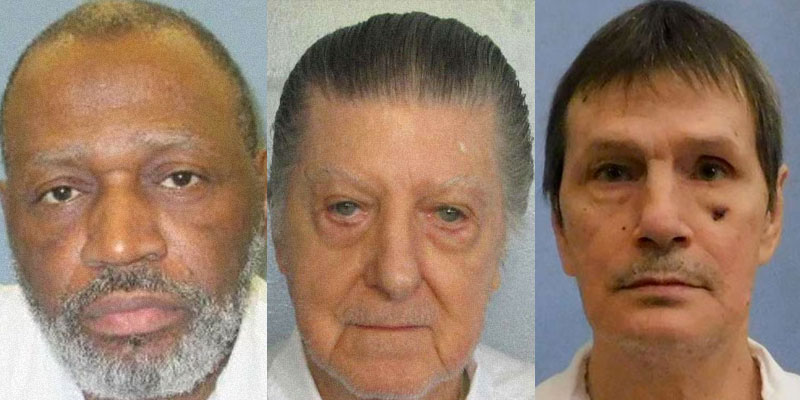Vernon Madison has spent decades on Alabama’s death row. Now 67, Madison has suffered from strokes and dementia and his lawyers say he no longer recalls the crime that put him there: the 1985 killing of a police officer.
His speech is slurred, he suffers from confusion, and once thought he was near release and talked of moving to Florida, according to his lawyers. This fall, the U.S. Supreme Court is set to review the claims by Madison’s defense team that executing someone in his condition would violate the Constitution’s ban on cruel and unusual punishment.
“Killing a fragile man suffering from dementia is unnecessary and cruel,” Madison’s attorney, Bryan Stevenson of the Equal Justice Initiative, said in January, when the justices stayed Madison’s execution the night he was to receive a lethal injection.
The U.S. death row population is aging, and that leaves courts increasingly likely to grapple with questions of when it becomes unconstitutionally cruel to put someone to death who is mentally frail — or whose medical conditions could complicate the execution procedure.
“That is going to be an increasing issue in carrying out the American death penalty,” said Robert Dunham, executive director of the Death Penalty Information Center in Washington. “We are reaching a stage, as death row inmates age, we’ll see this more frequently.”
About 2,800 people are on death row in prisons nationwide, and about 1,200 of them over age 50, the non-profit group said. An Associated Press review of the group’s data shows the median age of an executed inmate in the U.S. rose from 34 to 46 between 1983 and 2017 — a fact observers attribute to appeals taking longer — sometimes decades.
One of the oldest, 83-year-old Walter Leroy Moody, is scheduled to be executed Thursday in Alabama for the 1989 package bomb killing of a federal judge. If the sentence is carried out, Moody would be the oldest person and the first octogenarian put to death since U.S. executions resumed in the 1970s, Dunham said.
“Many of these defendants have done terrible things. People are torn between wanting to punish severely and the belief it is beneath us as a nation to kill a frail person who is already dying. It’s a challenge to our morality and our sense of humanity,” Dunham said.
Kent Scheidegger, legal director of the pro-death penalty Criminal Justice Legal Foundation, supports steps to reduce the time between an inmate’s sentencing and execution.
“There is no constitutional issue from age alone, though dementia does, of course, become more common with age. The underlying question about what kind and degree of mental illness will prevent an execution is not new. It is ancient.”
Justice Stephen G. Breyer, writing in Madison’s case, noted the growing number of aging prisoners on death row and said, “Given this trend, we may face ever more instances of state efforts to execute prisoners suffering the diseases and infirmities of old age.”
Age by itself isn’t the issue, but rather the illnesses more common with old age.
Take Alva Campbell, 69. He died last month in an Ohio prison of natural causes after his 2017 lethal injection procedure was halted when a usable vein couldn’t be found. Alabama similarly aborted last month’s execution of Doyle Lee Hamm, 61, who has battled lymphoma. His lawyer said Hamm had at least 11 puncture wounds from attempts to find a vein.
“It was precisely Doyle’s old age and illness that raised all the problems. The state of Alabama was not prepared,” Hamm’s attorney, Bernard Harcourt, wrote in an email.
Yet 75-year-old Tommy Arthur, who had argued that his cardiovascular disease would complicate execution, was put to death without obvious incident last year in Alabama.
Madison was convicted of killing Mobile police officer Julius Schulte.
Schulte responded to a missing child report on April 18, 1985. Arriving at a home, he found the child had returned but Madison and his girlfriend were embroiled in a domestic dispute. According to court records, Schulte interacted briefly with Madison, telling him to “just to go on and let things cool down.” According to prosecutors, Madison left but then crept up behind Schulte as he sat in his police car, shooting him twice in the head.
The Supreme Court has ruled inmates must have a rational understanding of why they’re being executed, faculties which Madison’s lawyers say he doesn’t possess.
His attorneys argue strokes have left Madison frequently disoriented with no independent memory of his crime. They also say he is legally blind, cannot walk independently and has urinary incontinence from his brain damage.
The state’s lawyers counter that Madison was found competent at a 2016 hearing, hasn’t presented new evidence and is aware he received the death sentence — even if he doesn’t remember killing Schulte.
“What happened to my dad was cruel and unusual punishment,” said Schulte’s son, Michael. “He was shot twice in the head while he was trying to help somebody.”
Schulte, 59, has suffered health problems of his own, including a stroke and heart attack. Yet he said Madison’s protracted legal fight has been hard on his family and doesn’t “do my dad justice.”
Said Schulte: “Somebody needs to make a decision. Either we are going to have the death penalty or we’re not.”
(Associated Press, copyright 2018)













